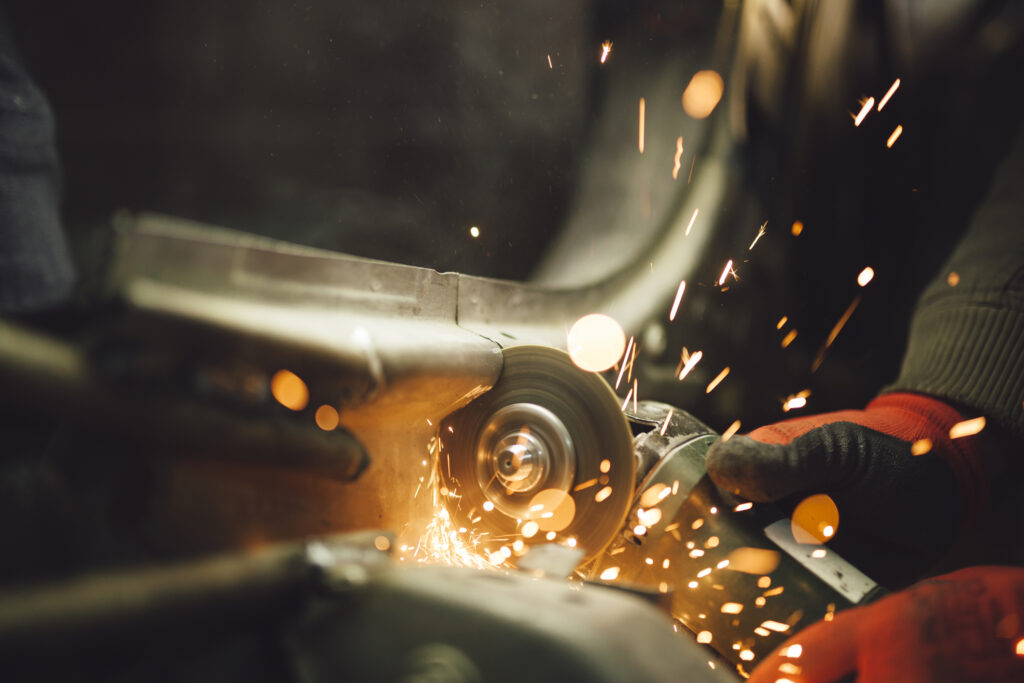When aluminum is cut, bent, or broken, it will behave differently than steel, so collision centers need to have specific equipment to perform aluminum structural repairs. This equipment will include such items as metal inert gas welders, plasma torches, rivet guns, and wet vacuums to pick up aluminum dust. Additionally, for the health and safety of employees, a separate work area for aluminum needs to be implemented in order to eliminate any steel and aluminum contamination issues.
In general, there are two primary safety concerns for collision employees when working with aluminum:
- Sparking, aluminothermic reactions, and combustible dust from aluminum grinding.
- Respiratory protection when using a plasma cutter with aluminum.
Aluminum Grinding
When aluminum grinding is performed, it is possible for sparking, aluminothermic reaction, and combustible dust creation to occur. When an aluminum particle and a metal oxide, such as rust, are ignited by a heat source, the reaction is similar to a firework explosion. This reaction can occur when a grinder is used on steel prior to being used on aluminum materials and vice versa. Because of this, all aluminum work must be separated from steel work.
Grinding alone could require the need for a hot work permit. OSHA does not define hot work based on specific types of materials or processes due to the endless possible combinations. The OSHA regulation 29 CFR 1915.4(r) defines hot work as “riveting, welding, burning, or other fire or spark producing operations.” Thus, regardless of the type of material being ground, if fire or sparks are produced under any of the conditions specified in 1915.504(b), then a fire watch is required to be posted. Conversely, if no fire or sparks are produced, then the operation is not considered hot work, and a fire watch is not required. In general to prevent sparks, an application of water any time aluminum grinding occurs is recommended.
Aluminum dust also can be combustible or explosive if it becomes suspended in the air at the right concentration. For example, one employee was killed and three others were severely burned in an Indiana plant that manufactures aluminum automotive wheels after a series of explosions was fueled by aluminum dust. OSHA has recognized the combustible nature of metal dusts in its Combustible Dust National Emphasis Program Directive. In addition, OSHA has issued a fact sheet, “Hazard Alert: Combustible Dust Explosions” Both of these documents describe the hazards and preventive measures associated with combustible dusts, like aluminum.
Respiratory Protection for Aluminum Cutting
In order to cut an aluminum alloy, a plasma torch is typically used. OSHA standards require a two-step approach to protect employees from health hazards caused by air contaminants, such as dust from plasma torch activities. The first step is to determine whether it is feasible to implement engineering controls to prevent the air from becoming contaminated. This may include limiting the activity to an enclosed space or using less toxic materials (CFR 1910.134(a)(1)). However, if no feasible means exists to prevent air contamination, the next step is to provide employees with suitable respiratory protection, such as a personal respirator. If respirators are worn by employees then the employer must implement a Respiratory Protection Program that is administered by a suitably trained person (CFR 1910.134(a)(2) and 1910.134(c)). The Respiratory Protection Program must be in writing and specific to the workplace. OSHA provides a guide called the “Small Entity Compliance Guide for the Respiratory Protection Standard” that provides a checklist of requirements for a suitable program, information on selecting appropriate safety equipment, and a sample written respiratory program. Additionally, if activities onsite require that respirators are worn, a medical evaluation and respiratory fit test would be required before a respirator is worn by an employee.
What To Do Next
- Make sure employees are aware of risks associated with aluminum in collision center activities.
- Ensure all equipment used in aluminum cutting and grinding operations are segregated from steel operations.
- Verify your Respiratory Protection Program is up to date and reflects the use of aluminum. Be sure a hazard assessment associated with its use has also been completed.
If you need assistance with risk evaluation, your Respiratory Protection Program, or any other questions, please contact us.

